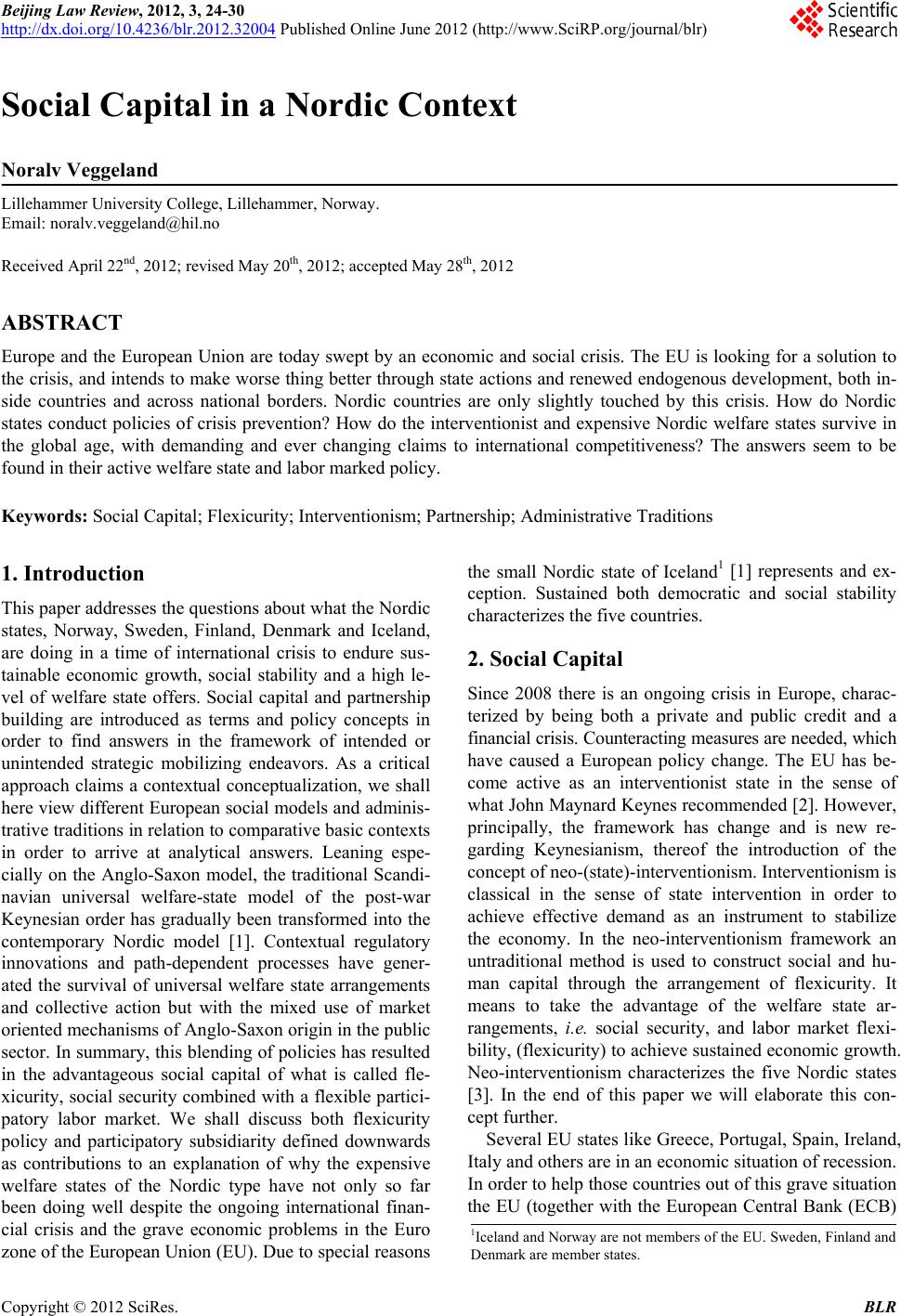 Beijing Law Review, 2012, 3, 24-30 http://dx.doi.org/10.4236/blr.2012.32004 Published Online June 2012 (http://www.SciRP.org/journal/blr) Social Capital in a Nordic Context Noralv Veggeland Lillehammer University College, Lillehammer, Norway. Email: noralv.veggeland@hil.no Received April 22nd, 2012; revised May 20th, 2012; accepted May 28th, 2012 ABSTRACT Europe and the European Union are today swept by an economic and social crisis. The EU is looking for a solution to the crisis, and intends to make worse thing better through state actions and renewed endogenous development, both in- side countries and across national borders. Nordic countries are only slightly touched by this crisis. How do Nordic states conduct policies of crisis prevention? How do the interventionist and expensive Nordic welfare states survive in the global age, with demanding and ever changing claims to international competitiveness? The answers seem to be found in their active welfare state and labor marked policy. Keywords: Social Capital; Flexicurity; Interventionism; Partnership; Administrative Traditions 1. Introduction This paper addresses the questions about what the Nordic states, Norway, Sweden, Finland, Denmark and Iceland, are doing in a time of international crisis to endure sus- tainable economic growth, social stability and a high le- vel of welfare state offers. Social capital and partnership building are introduced as terms and policy concepts in order to find answers in the framework of intended or unintended strategic mobilizing endeavors. As a critical approach claims a contextual conceptualization, we shall here view different European social models and adminis- trative traditions in relation to comparative basic co ntexts in order to arrive at analytical answers. Leaning espe- cially on the Anglo-Saxon model, the traditional Scandi- navian universal welfare-state model of the post-war Keynesian order has gradually been transformed into the contemporary Nordic model [1]. Contextual regulatory innovations and path-dependent processes have gener- ated the survival of universal welfare state arrangements and collective action but with the mixed use of market oriented mechanisms of Anglo-Saxon origin in the public sector. In summary, this blending of po licies has resulted in the advantageous social capital of what is called fle- xicurity, social security combined with a flexible partici- patory labor market. We shall discuss both flexicurity policy and participatory subsidiarity defined downwards as contributions to an explanation of why the expensive welfare states of the Nordic type have not only so far been doing well despite the ongoing international finan- cial crisis and the grave economic problems in the Euro zone of the European Union (EU). Due to special reasons the small Nordic state of Iceland1 [1] represents and ex- ception. Sustained both democratic and social stability characterizes the five countries. 2. Social Capital Since 2008 there is an ongoing crisis in Europe, charac- terized by being both a private and public credit and a financial crisis. Counteracting measures are needed, which have caused a European policy change. The EU has be- come active as an interventionist state in the sense of what John Maynard Keynes recommended [2]. However, principally, the framework has change and is new re- garding Keynesianism, thereof the introduction of the concept of neo-(state)-interventionism. Interv entionism is classical in the sense of state intervention in order to achieve effective demand as an instrument to stabilize the economy. In the neo-interventionism framework an untraditional method is used to construct social and hu- man capital through the arrangement of flexicurity. It means to take the advantage of the welfare state ar- rangements, i.e. social security, and labor market flexi- bility, (flexicurity) to achiev e sustained economic growth. Neo-interventionism characterizes the five Nordic states [3]. In the end of this paper we will elaborate this con- cept further. Several EU states like Greece, Portugal, Spain, Ireland, Italy and others are in an economic situation of recession. In order to help those countries out of this grave situation the EU (together with the European Central Bank (ECB) 1Iceland and Norway are not members of the EU. Sweden, Finland and Denmark are member states. Copyright © 2012 SciRes. BLR 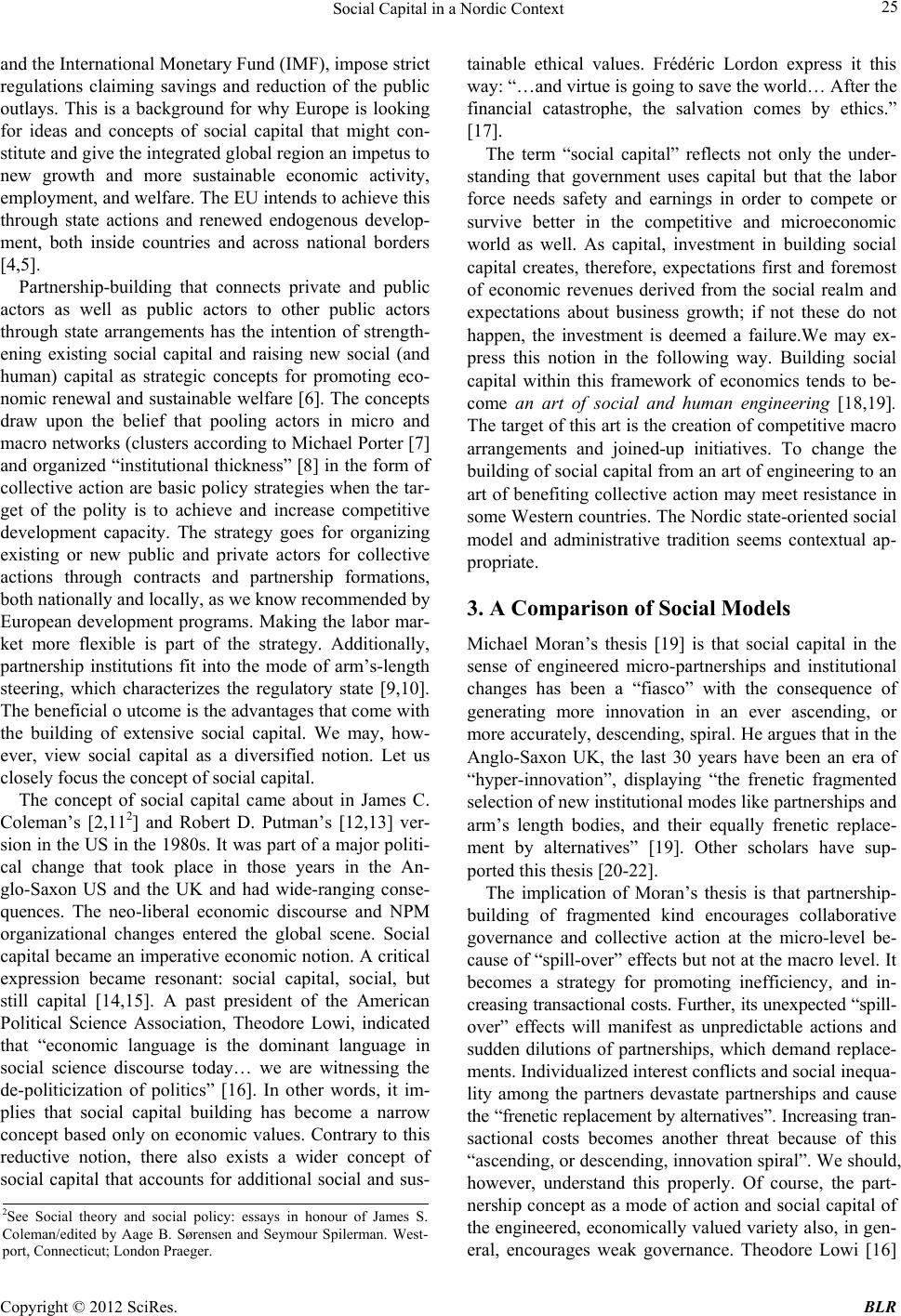 Social Capital in a Nordic Context 25 and the International Monetary Fun d (IMF), impose strict regulations claiming savings and reduction of the public outlays. This is a background for why Europe is looking for ideas and concepts of social capital that might con- stitute and give the integrated global reg ion an impetus to new growth and more sustainable economic activity, employment, and welfare. The EU intends to achieve this through state actions and renewed endogenous develop- ment, both inside countries and across national borders [4,5]. Partnership-building that connects private and public actors as well as public actors to other public actors through state arrangements has the intention of strength- ening existing social capital and raising new social (and human) capital as strategic concepts for promoting eco- nomic renewal and sustainable welfare [6]. The concepts draw upon the belief that pooling actors in micro and macro networks (clusters according to Michael Porter [7] and organized “institu tional thickness” [8] in the form of collective action are basic policy strategies when the tar- get of the polity is to achieve and increase competitive development capacity. The strategy goes for organizing existing or new public and private actors for collective actions through contracts and partnership formations, both nationally and locally, as we know recommended by European development programs. Making the labor mar- ket more flexible is part of the strategy. Additionally, partnership institutions fit into the mode of arm’s-length steering, which characterizes the regulatory state [9,10]. The beneficial o utcome is the advantages that come with the building of extensive social capital. We may, how- ever, view social capital as a diversified notion. Let us closely focus the concept of social capital. The concept of social capital came about in James C. Coleman’s [2,112] and Robert D. Putman’s [12,13] ver- sion in the US in the 1980s. It was part o f a major politi- cal change that took place in those years in the An- glo-Saxon US and the UK and had wide-ranging conse- quences. The neo-liberal economic discourse and NPM organizational changes entered the global scene. Social capital became an imperative economic notion. A critical expression became resonant: social capital, social, but still capital [14,15]. A past president of the American Political Science Association, Theodore Lowi, indicated that “economic language is the dominant language in social science discourse today… we are witnessing the de-politicization of politics” [16]. In other words, it im- plies that social capital building has become a narrow concept based only on economic values. Contrary to this reductive notion, there also exists a wider concept of social capital that accounts for additional social and sus- tainable ethical values. Frédéric Lordon express it this way: “…and virtue is going to save the world… After the financial catastrophe, the salvation comes by ethics.” [17]. The term “social capital” reflects not only the under- standing that government uses capital but that the labor force needs safety and earnings in order to compete or survive better in the competitive and microeconomic world as well. As capital, investment in building social capital creates, therefore, expectations first and foremost of economic revenues derived from the social realm and expectations about business growth; if not these do not happen, the investment is deemed a failure.We may ex- press this notion in the following way. Building social capital within this framework of economics tends to be- come an art of social and human engineering [18,19]. The target of this art is the creation of competitive macro arrangements and joined-up initiatives. To change the building of social capital from an art of engineering to an art of benefiting collective action may meet resistance in some Western countries. The Nordic state-oriented social model and administrative tradition seems contextual ap- propriate. 3. A Comparison of Social Models Michael Moran’s thesis [19] is that social capital in the sense of engineered micro-partnerships and institutional changes has been a “fiasco” with the consequence of generating more innovation in an ever ascending, or more accurately, descending, spiral. He argues that in the Anglo-Saxon UK, the last 30 years have been an era of “hyper-innovation”, displaying “the frenetic fragmented selection of new institutio na l modes like p artn ersh ips an d arm’s length bodies, and their equally frenetic replace- ment by alternatives” [19]. Other scholars have sup- ported this thesis [20-22]. The implication of Moran’s thesis is that partnership- building of fragmented kind encourages collaborative governance and collective action at the micro-level be- cause of “spill-over” effects but not at the macro level. It becomes a strategy for promoting inefficiency, and in- creasing transactional costs. Further, its unex pected “spill- over” effects will manifest as unpredictable actions and sudden dilutions of partnerships, which demand replace- ments. Individualized interest conflicts and social inequ a- lity among the partners devastate partnerships and cause the “frenetic replacement by alternatives”. Increasing tran- sactional costs becomes another threat because of this “ascending, or descending, innovation spiral”. We should, however, understand this properly. Of course, the part- nership concept as a mode of action and social capital of the engineered, economically valued variety also, in gen- eral, encourages weak governance. Theodore Lowi [16] 2See Social theory and social policy: essays in honour of James S. Coleman/edited by Aage B. Sørensen and Seymour Spilerman. West- ort, Connecticut; London Praege . Copyright © 2012 SciRes. BLR 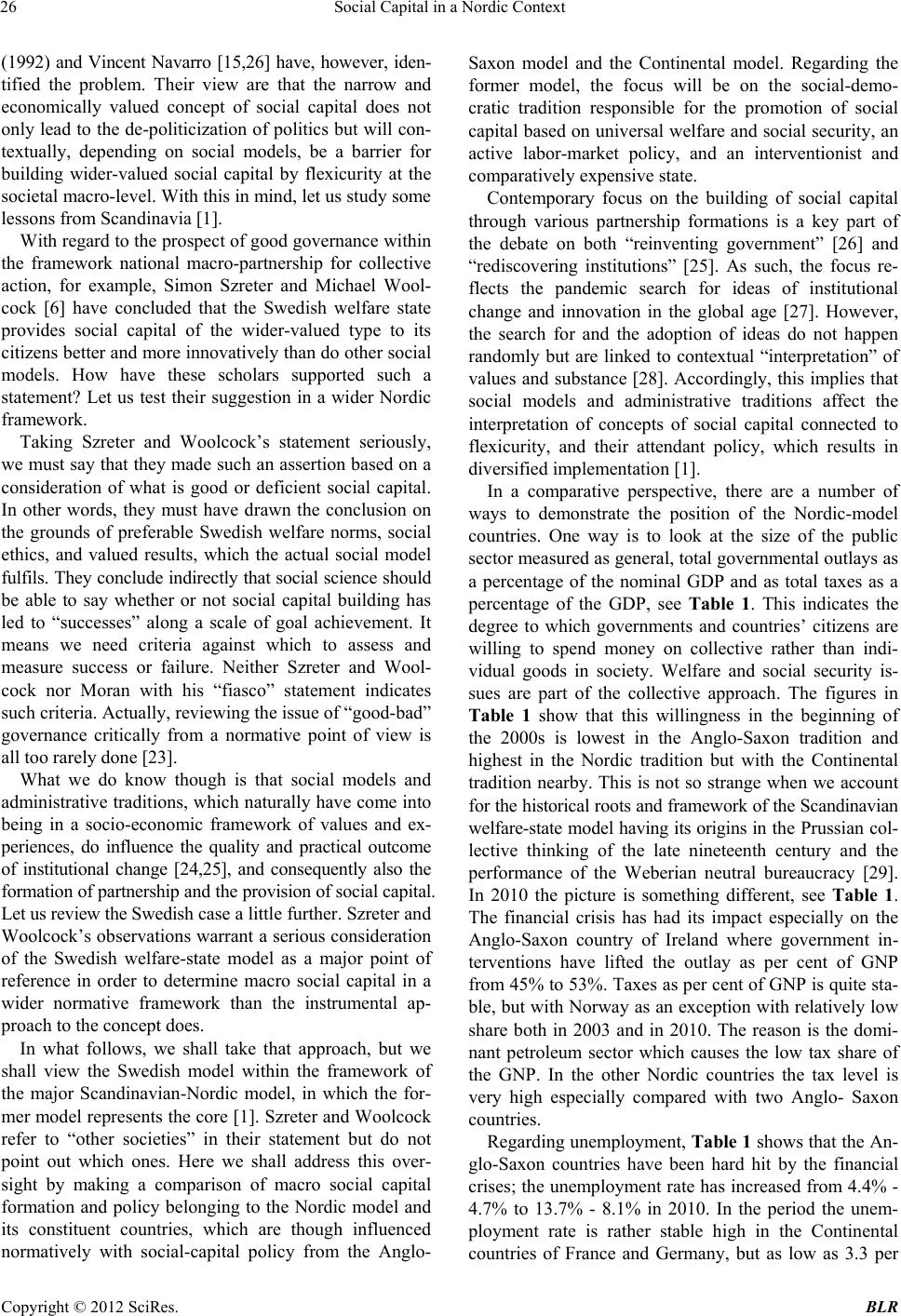 Social Capital in a Nordic Context 26 (1992) and Vincent Navarro [15,26] have, however, iden- tified the problem. Their view are that the narrow and economically valued concept of social capital does not only lead to the de-politicization of politics but will con- textually, depending on social models, be a barrier for building wider-valued social capital by flexicurity at the societal macro-level. With this in mind, let us study some lessons from Scandinavia [1]. With regard to the prospect of good governance within the framework national macro-partnership for collective action, for example, Simon Szreter and Michael Wool- cock [6] have concluded that the Swedish welfare state provides social capital of the wider-valued type to its citizens better and more innov atively than do other social models. How have these scholars supported such a statement? Let us test their suggestion in a wider Nordic framework. Taking Szreter and Woolcock’s statement seriously, we must say that they made such an assertion based on a consideration of what is good or deficient social capital. In other words, they must have drawn the conclusion on the grounds of preferable Swedish welfare norms, social ethics, and valued results, which the actual social model fulfils. They conclude indirectly that social science should be able to say whether or not social capital building has led to “successes” along a scale of goal achievement. It means we need criteria against which to assess and measure success or failure. Neither Szreter and Wool- cock nor Moran with his “fiasco” statement indicates such criteria. Actually, reviewing the issue of “good-bad” governance critically from a normative point of view is all too rarely d on e [23]. What we do know though is that social models and administrative traditions, which naturally have co me into being in a socio-economic framework of values and ex- periences, do influence the quality and practical outcome of institutional change [24,25], and consequently also the formation of partnership and the provision of social capital. Let us review the Swedish case a little further. Szreter and Woolcock’s observations warrant a serious consideration of the Swedish welfare-state model as a major point of reference in order to determine macro social capital in a wider normative framework than the instrumental ap- proach to the concept does. In what follows, we shall take that approach, but we shall view the Swedish model within the framework of the major Scandinavian-Nordic model, in which the for- mer model represents the core [1]. Szreter and Woolcock refer to “other societies” in their statement but do not point out which ones. Here we shall address this over- sight by making a comparison of macro social capital formation and policy belonging to the Nordic model and its constituent countries, which are though influenced normatively with social-capital policy from the Anglo- Saxon model and the Continental model. Regarding the former model, the focus will be on the social-demo- cratic tradition responsible for the promotion of social capital based on univ ersal welfare and social security, an active labor-market policy, and an interventionist and comparatively expensive state. Contemporary focus on the building of social capital through various partnership formations is a key part of the debate on both “reinventing government” [26] and “rediscovering institutions” [25]. As such, the focus re- flects the pandemic search for ideas of institutional change and innovation in the global age [27]. However, the search for and the adoption of ideas do not happen randomly but are linked to contextual “interpretation” of values and substance [28]. Accordingly, this implies that social models and administrative traditions affect the interpretation of concepts of social capital connected to flexicurity, and their attendant policy, which results in diversified implementation [1]. In a comparative perspective, there are a number of ways to demonstrate the position of the Nordic-model countries. One way is to look at the size of the public sector measured as general, total governmental outlays as a percentage of the nominal GDP and as total taxes as a percentage of the GDP, see Table 1. This indicates the degree to which governments and countries’ citizens are willing to spend money on collective rather than indi- vidual goods in society. Welfare and social security is- sues are part of the collective approach. The figures in Table 1 show that this willingness in the beginning of the 2000s is lowest in the Anglo-Saxon tradition and highest in the Nordic tradition but with the Continental tradition nearby. This is not so strange when we account for the historical roots and framework of the Scandinavian welfare-state model having its origins in th e Pr ussi an co l- lective thinking of the late nineteenth century and the performance of the Weberian neutral bureaucracy [29]. In 2010 the picture is something different, see Table 1. The financial crisis has had its impact especially on the Anglo-Saxon country of Ireland where government in- terventions have lifted the outlay as per cent of GNP from 45% to 53%. Taxes as per cent of GNP is quite sta- ble, but with Norway as an exception with relatively lo w share both in 2003 and in 2010. The reason is the domi- nant petroleum sector which causes the low tax share of the GNP. In the other Nordic countries the tax level is very high especially compared with two Anglo- Saxon countries. Regarding unemployment, Table 1 shows that th e An- glo-Saxon countries have been hard hit by the financial crises; the unemployment rate has increased from 4.4% - 4.7% to 13.7% - 8.1% in 2010. In the period the unem- ployment rate is rather stable high in the Continental countries of France and Germany, but as low as 3.3 per Copyright © 2012 SciRes. BLR 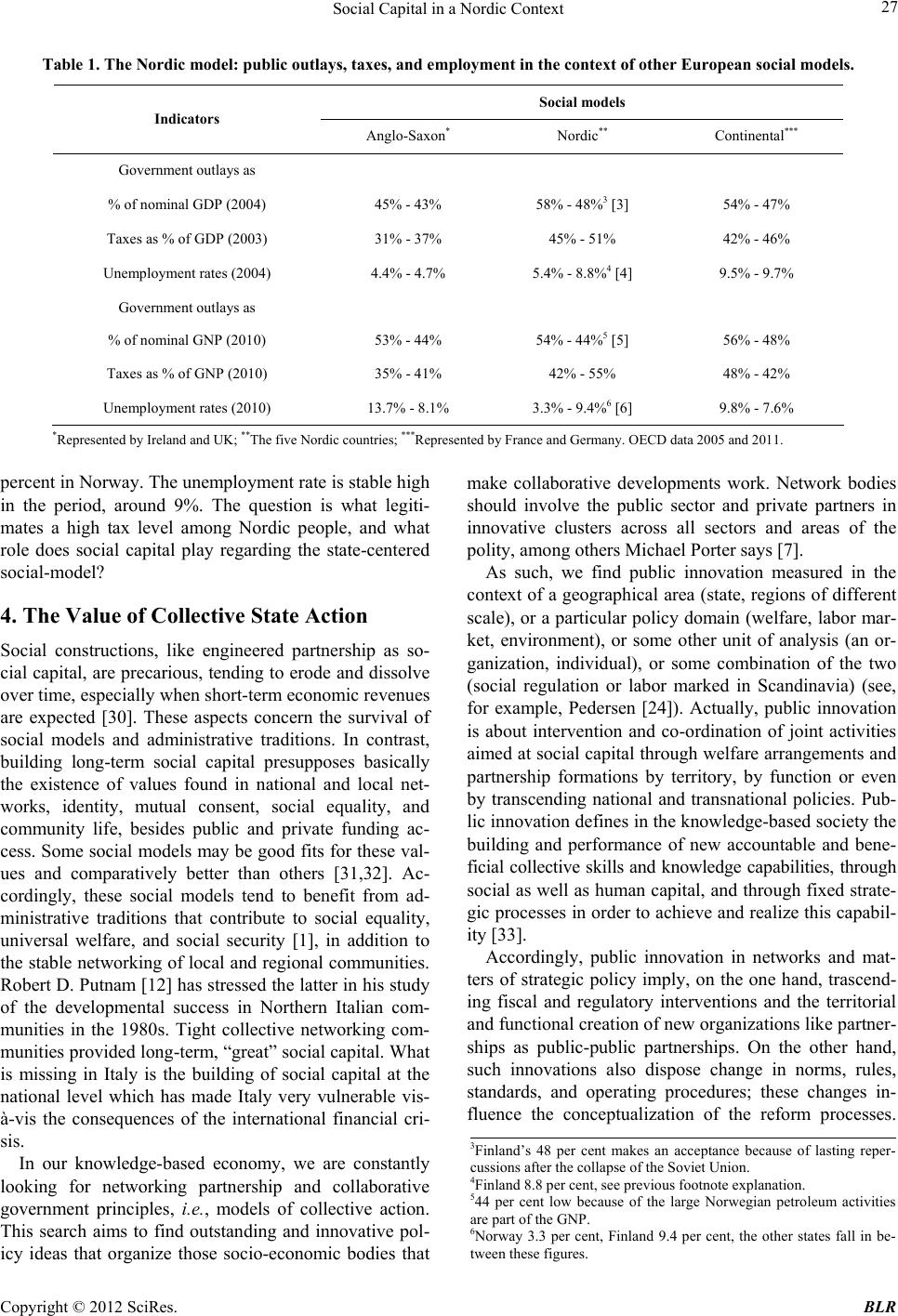 Social Capital in a Nordic Context Copyright © 2012 SciRes. BLR 27 Table 1. The Nordic model: public outlays, taxes, and e m ployment in the context of other European social models. Social models Indicators Anglo-Saxon* Nordic** Continental*** Government outlays as % of nominal GDP ( 20 04 ) 45% - 43% 58% - 48%3 [3] 54% - 47% Taxes as % of GDP (2003) 31% - 37% 45% - 51% 42% - 46% Unemployment rates (2004) 4.4% - 4.7% 5.4% - 8.8%4 [4] 9.5% - 9.7% Government outlays as % of nominal GNP ( 20 10 ) 53% - 44% 54% - 44%5 [5] 56% - 48% Taxes as % of GNP (2010) 35% - 41% 42% - 55% 48% - 42% Unemployment rates (2010) 13.7% - 8.1% 3.3% - 9.4%6 [6] 9.8% - 7.6% *Represented by Ireland and UK; **The five Nordic countries ; ***Represented by France and Germany. OECD data 2005 and 2011. percent in Norway. The unemployment rate is stable high in the period, around 9%. The question is what legiti- mates a high tax level among Nordic people, and what role does social capital play regarding the state-centered social-model? 4. The Value of Collective State Action Social constructions, like engineered partnership as so- cial capital, are precarious, tending to erode and dissolve over time, especially when short-term economic revenues are expected [30]. These aspects concern the survival of social models and administrative traditions. In contrast, building long-term social capital presupposes basically the existence of values found in national and local net- works, identity, mutual consent, social equality, and community life, besides public and private funding ac- cess. Some social models may be good fits for these val- ues and comparatively better than others [31,32]. Ac- cordingly, these social models tend to benefit from ad- ministrative traditions that contribute to social equality, universal welfare, and social security [1], in addition to the stable networking of local and region al communities. Robert D. Putnam [12] has stressed the latter in his study of the developmental success in Northern Italian com- munities in the 1980s. Tight collective networking com- munities provided long-term, “great” social capital. What is missing in Italy is the building of social capital at the national level which has made Italy very vulnerable vis- à-vis the consequences of the international financial cri- sis. In our knowledge-based economy, we are constantly looking for networking partnership and collaborative government principles, i.e., models of collective action. This search aims to find outstanding and innovative pol- icy ideas that organize those socio-economic bodies that make collaborative developments work. Network bodies should involve the public sector and private partners in innovative clusters across all sectors and areas of the polity, among others Michael Porter says [7]. As such, we find public innovation measured in the context of a geographical area (state, regions of different scale), or a particular policy domain (welfare, labor mar- ket, environment), or some other unit of analysis (an or- ganization, individual), or some combination of the two (social regulation or labor marked in Scandinavia) (see, for example, Pedersen [24]). Actually, public innovation is about intervention and co-ordination of joint activities aimed at social capital through welfare arr angements and partnership formations by territory, by function or even by transcending national and transnational policies. Pub- lic innovation defines in the knowledge-based society the building and performance of new accountable and bene- ficial collective skills and knowledge capabilities, through social as well as human capital, and through fix ed strate- gic processes in order to achieve and realize this capabil- ity [33]. Accordingly, public innovation in networks and mat- ters of strategic policy imply, on the one hand, trascend- ing fiscal and regulatory interventions and the territorial and functional creation of new organizations like partner- ships as public-public partnerships. On the other hand, such innovations also dispose change in norms, rules, standards, and operating procedures; these changes in- fluence the conceptualization of the reform processes. 3Finland’s 48 per cent makes an acceptance because of lasting reper- cussions after the collapse of the Soviet Union. 4Finland 8.8 per cent, see previous footnote explanation. 544 per cent low because of the large Norwegian petroleum activities are part of the GNP. 6Norway 3.3 per cent, Finland 9.4 per cent, the other states fall in be- tween these figures. 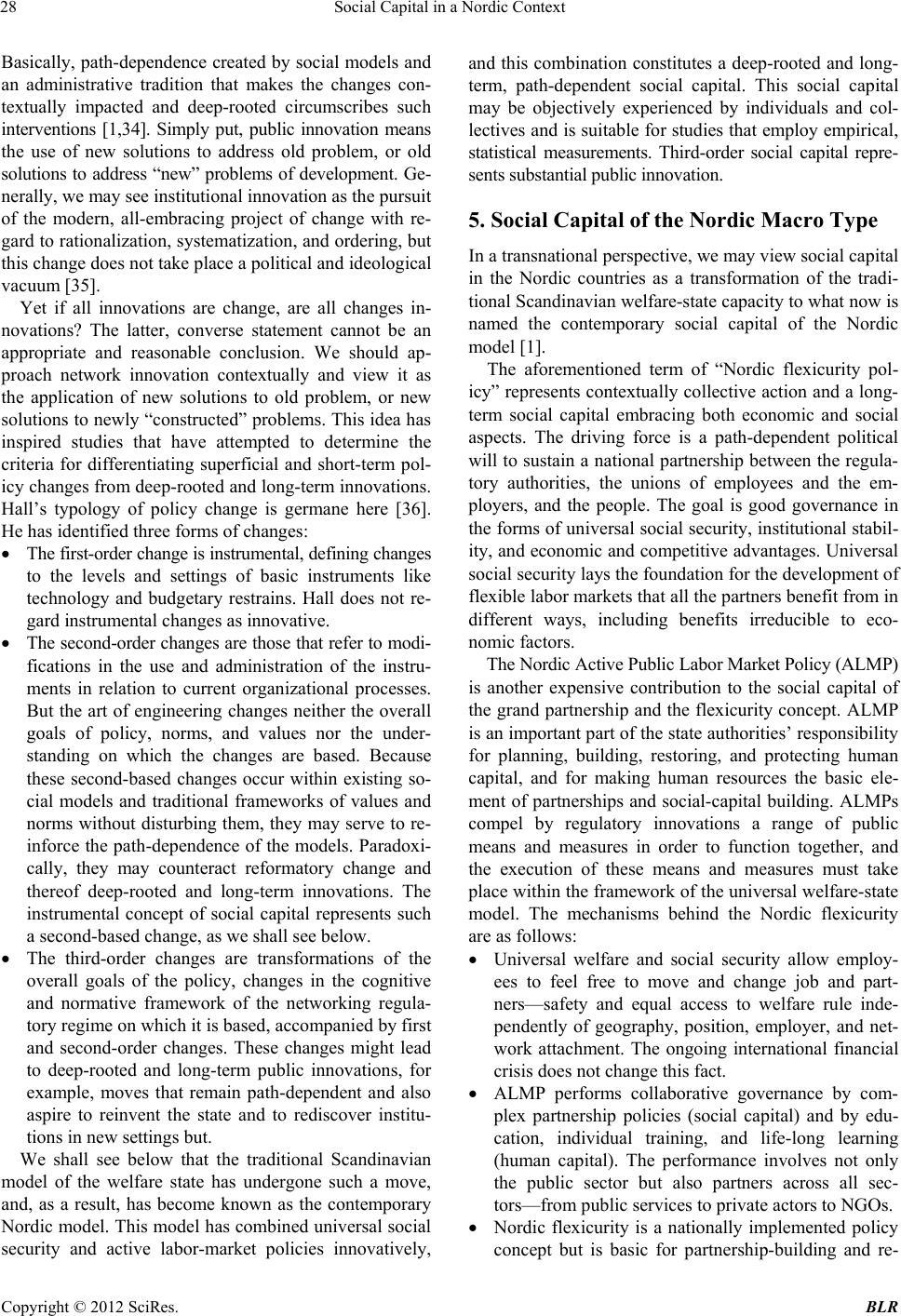 Social Capital in a Nordic Context 28 Basically, path-dependence created by social models and an administrative tradition that makes the changes con- textually impacted and deep-rooted circumscribes such interventions [1,34]. Simply put, public innovation means the use of new solutions to address old problem, or old solutions to address “new” problems of development. Ge- nerally, we may see institutional innovation as the pu rsuit of the modern, all-embracing project of change with re- gard to rationalization, systematization, and ordering, but this change does no t take place a p olitical an d ideological vacuum [35]. Yet if all innovations are change, are all changes in- novations? The latter, converse statement cannot be an appropriate and reasonable conclusion. We should ap- proach network innovation contextually and view it as the application of new solutions to old problem, or new solutions to newly “constructed” prob lems. This idea has inspired studies that have attempted to determine the criteria for differentiating superficial and short-term pol- icy changes from deep-rooted and long-term innovations. Hall’s typology of policy change is germane here [36]. He has identified three forms of changes: The first-order change is instrumental, defining changes to the levels and settings of basic instruments like technology and budgetary restrains. Hall does not re- gard instrumental changes as innovative. The second-order changes are those that refer to modi- fications in the use and administration of the instru- ments in relation to current organizational processes. But the art of engineering changes neither the overall goals of policy, norms, and values nor the under- standing on which the changes are based. Because these second-based changes occur within existing so- cial models and traditional frameworks of values and norms without disturbing them, they may serve to re- inforce the path-dependence of the models. Paradoxi- cally, they may counteract reformatory change and thereof deep-rooted and long-term innovations. The instrumental concept of social capital represents such a second-based change, as we shall see below. The third-order changes are transformations of the overall goals of the policy, changes in the cognitive and normative framework of the networking regula- tory regime on which it is based, accompanied by first and second-order changes. These changes might lead to deep-rooted and long-term public innovations, for example, moves that remain path-dependent and also aspire to reinvent the state and to rediscover institu- tions in new settings but. We shall see below that the traditional Scandinavian model of the welfare state has undergone such a move, and, as a result, has become known as the contemporary Nordic model. This model has combined universal social security and active labor-market policies innovatively, and this combination constitutes a deep-rooted and long- term, path-dependent social capital. This social capital may be objectively experienced by individuals and col- lectives and is suitable for studies that employ empirical, statistical measurements. Third-order social capital repre- sents substantial public innovation. 5. Social Capital of the Nordic Macro Type In a transnational persp ective, we may view social capital in the Nordic countries as a transformation of the tradi- tional Scandinavian welfare-state capacity to what now is named the contemporary social capital of the Nordic model [1]. The aforementioned term of “Nordic flexicurity pol- icy” represents contex tually collective action and a long- term social capital embracing both economic and social aspects. The driving force is a path-dependent political will to sustain a national partnership between the regula- tory authorities, the unions of employees and the em- ployers, and the people. The goal is good governance in the forms of universal social security, in stitutional stabil- ity, and economic and competitive ad vantages. Universal social security lays the foundation for the development of flexible labor markets that all the partn ers benefit from in different ways, including benefits irreducible to eco- nomic factors. The Nordic Active Public Labor Market Policy (ALMP) is another expensive contribution to the social capital of the grand partnership and the flexicurity concept. ALMP is an important part of the state authorities’ responsibility for planning, building, restoring, and protecting human capital, and for making human resources the basic ele- ment of partnerships and social-capital building. ALMPs compel by regulatory innovations a range of public means and measures in order to function together, and the execution of these means and measures must take place within the framework of the universal welfare-state model. The mechanisms behind the Nordic flexicurity are as follows: Universal welfare and social security allow employ- ees to feel free to move and change job and part- ners—safety and equal access to welfare rule inde- pendently of geography, position, employer, and net- work attachment. The ongoing international financial crisis does not change this fact. ALMP performs collaborative governance by com- plex partnership policies (social capital) and by edu- cation, individual training, and life-long learning (human capital). The performance involves not only the public sector but also partners across all sec- tors—from public services to private actors to NGOs. Nordic flexicurity is a nationally implemented policy concept but is basic for partnership-building and re- Copyright © 2012 SciRes. BLR 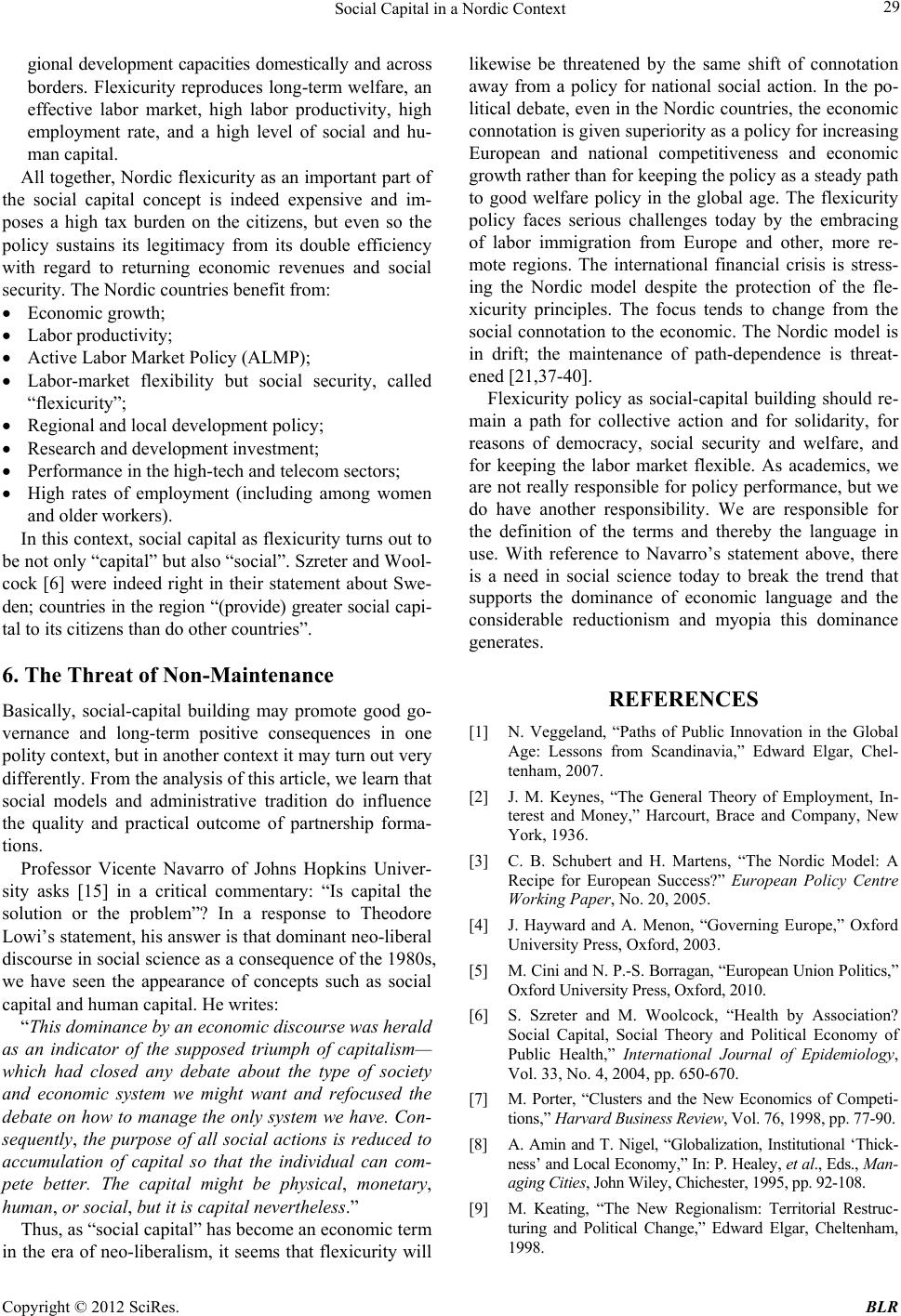 Social Capital in a Nordic Context 29 gional development capacities domestically and across borders. Flexicurity reproduces long-term welfare, an effective labor market, high labor productivity, high employment rate, and a high level of social and hu- man capital. All together, Nordic flex icurity as an important part of the social capital concept is indeed expensive and im- poses a high tax burden on the citizens, but even so the policy sustains its legitimacy from its double efficiency with regard to returning economic revenues and social security. The Nordic countries benefit from: Economic growth; Labor productivity; Active Labor Market Policy (ALMP); Labor-market flexibility but social security, called “flexicurity”; Regional and local development policy; Research and development investment; Performance in the high-tech and telecom sectors; High rates of employment (including among women and older workers). In this context, so cial capital as flexicurity turns out to be not only “capital” but also “social”. Szreter and Wool- cock [6] were indeed right in their statement about Swe- den; countries in the region “(provide) greater social capi- tal to its citizens than do other countries”. 6. The Threat of Non-Maintenance Basically, social-capital building may promote good go- vernance and long-term positive consequences in one polity context, but in an other contex t it may turn ou t very differently. From the analysis of this article, we learn that social models and administrative tradition do influence the quality and practical outcome of partnership forma- tions. Professor Vicente Navarro of Johns Hopkins Univer- sity asks [15] in a critical commentary: “Is capital the solution or the problem”? In a response to Theodore Lowi’s statement, his answer is that dominant neo-liberal discourse in social science as a consequence of the 1980s, we have seen the appearance of concepts such as social capital and human capital. He writes: “This dominance by an economic discourse was herald as an indicator of the supposed triumph of capitalism— which had closed any debate about the type of society and economic system we might want and refocused the debate on how to manage the on ly system we have. Con- sequently, the purpose of all social actions is reduced to accumulation of capital so that the individual can com- pete better. The capital might be physical, monetary, human, or soci al , but it is capital nevertheless.” Thus, as “social capital” has become an economic term in the era of neo-liberalism, it seems that flexicurity will likewise be threatened by the same shift of connotation away from a policy for national social action. In the po- litical debate, even in the Nordic countries, the economic connotation is given su periority as a policy f or incr easing European and national competitiveness and economic growth rather than for keeping the policy as a steady path to good welfare policy in the global age. The flexicurity policy faces serious challenges today by the embracing of labor immigration from Europe and other, more re- mote regions. The international financial crisis is stress- ing the Nordic model despite the protection of the fle- xicurity principles. The focus tends to change from the social connotation to the economic. The Nordic model is in drift; the maintenance of path-dependence is threat- ened [21,37-40]. Flexicurity policy as social-capital building should re- main a path for collective action and for solidarity, for reasons of democracy, social security and welfare, and for keeping the labor market flexible. As academics, we are not really responsible for policy performance, but we do have another responsibility. We are responsible for the definition of the terms and thereby the language in use. With reference to Navarro’s statement above, there is a need in social science today to break the trend that supports the dominance of economic language and the considerable reductionism and myopia this dominance generates. REFERENCES [1] N. Veggeland, “Paths of Public Innovation in the Global Age: Lessons from Scandinavia,” Edward Elgar, Chel- tenham, 2007. [2] J. M. Keynes, “The General Theory of Employment, In- terest and Money,” Harcourt, Brace and Company, New York, 1936. [3] C. B. Schubert and H. Martens, “The Nordic Model: A Recipe for European Success?” European Policy Centre Working Paper, No. 20, 2005. [4] J. Hayward and A. Menon, “Governing Europe,” Oxford University Press, Oxford, 2003. [5] M. Cini and N. P.-S. Borragan, “European Union Politics,” Oxford University Press, Oxford, 2010. [6] S. Szreter and M. Woolcock, “Health by Association? Social Capital, Social Theory and Political Economy of Public Health,” International Journal of Epidemiology, Vol. 33, No. 4, 2004, pp. 650-670. [7] M. Porter, “Clusters and the New Economics of Competi- tions,” Harvard Business Review, Vol. 76, 1998, pp. 77-90. [8] A. Amin and T. Nigel, “Globalization, Institutional ‘Thick- ness’ and Local Economy,” In: P. Healey , et al., Eds., Man- aging Cities, John Wiley, Chichester, 1995, pp. 92-108. [9] M. Keating, “The New Regionalism: Territorial Restruc- turing and Political Change,” Edward Elgar, Cheltenham, 1998. Copyright © 2012 SciRes. BLR 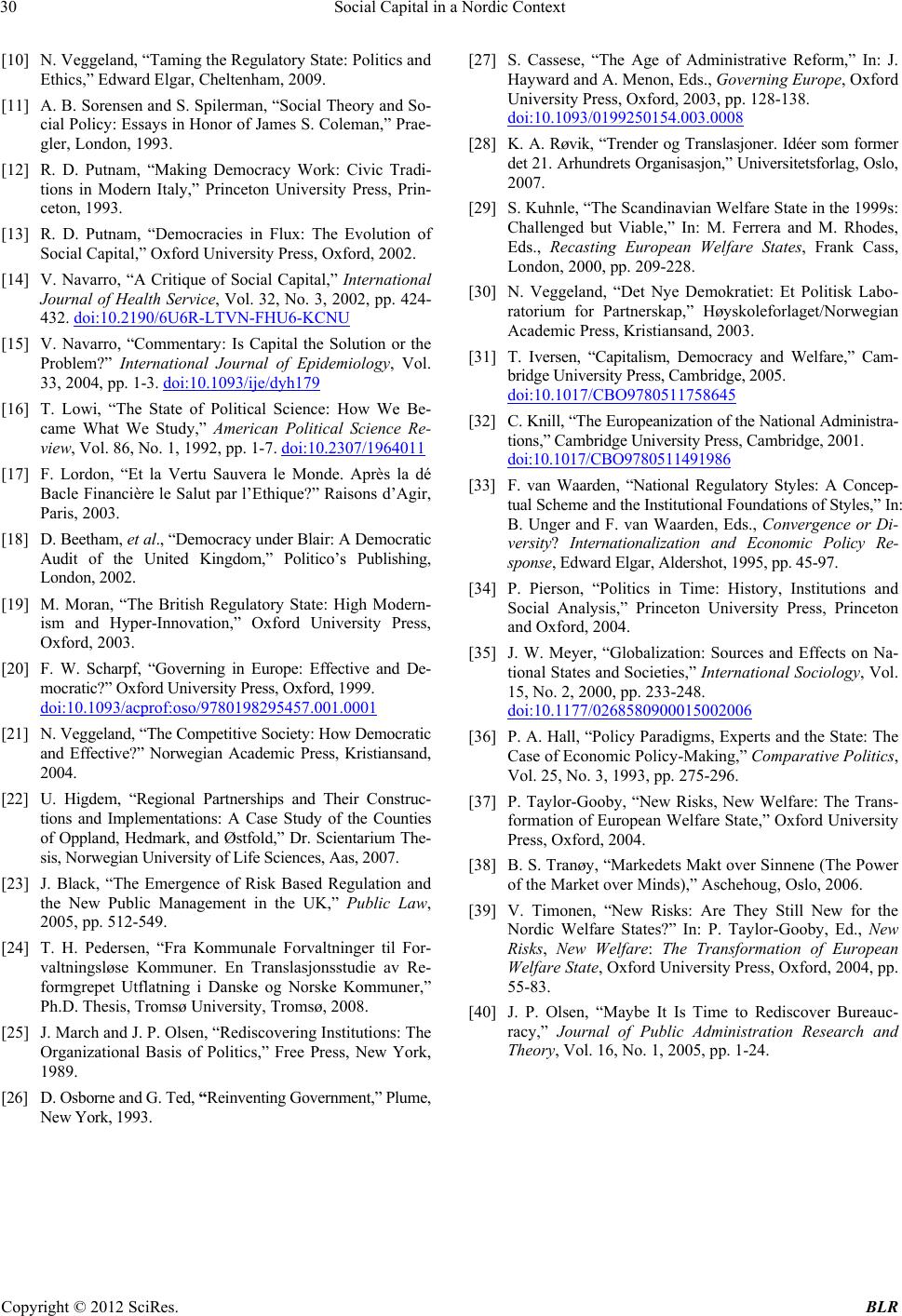 Social Capital in a Nordic Context Copyright © 2012 SciRes. BLR 30 [10] N. Veggeland, “Taming the Regulatory State: Politics and Ethics,” Edward Elgar, Cheltenham, 2009. [11] A. B. Sorensen and S. Spilerman, “Social Theory and So- cial Policy: Essays in Honor of James S. Coleman,” Prae- gler, London, 1993. [12] R. D. Putnam, “Making Democracy Work: Civic Tradi- tions in Modern Italy,” Princeton University Press, Prin- ceton, 1993. [13] R. D. Putnam, “Democracies in Flux: The Evolution of Social Capital,” Oxford University Press, Oxford, 2002. [14] V. Navarro, “A Critique of Social Capital,” International Journal of Health Service, Vol. 32, No. 3, 2002, pp. 424- 432. doi:10.2190/6U6R-LTVN-FHU6-KCNU [15] V. Navarro, “Commentary: Is Capital the Solution or the Problem?” International Journal of Epidemiology, Vol. 33, 2004, pp. 1-3. doi:10.1093/ije/dyh179 [16] T. Lowi, “The State of Political Science: How We Be- came What We Study,” American Political Science Re- view, Vol. 86, No. 1, 1992, pp. 1-7. doi:10.2307/1964011 [17] F. Lordon, “Et la Vertu Sauvera le Monde. Après la dé Bacle Financière le Salut par l’Ethique?” Raisons d’Agir, Paris, 2003. [18] D. Beetham, et al., “Democracy under Blair: A De moc ratic Audit of the United Kingdom,” Politico’s Publishing, London, 2002. [19] M. Moran, “The British Regulatory State: High Modern- ism and Hyper-Innovation,” Oxford University Press, Oxford, 2003. [20] F. W. Scharpf, “Governing in Europe: Effective and De- mocratic?” Oxford University Press, Oxford, 1999. doi:10.1093/acprof:oso/9780198295457.001.0001 [21] N. Veggeland, “The Competitive Society: How Democratic and Effective?” Norwegian Academic Press, Kristiansand, 2004. [22] U. Higdem, “Regional Partnerships and Their Construc- tions and Implementations: A Case Study of the Counties of Oppland, Hedmark, and Østfold,” Dr. Scientarium The- sis, Norwegian University of Life Sciences, Aas, 2007. [23] J. Black, “The Emergence of Risk Based Regulation and the New Public Management in the UK,” Public Law, 2005, pp. 512-549. [24] T. H. Pedersen, “Fra Kommunale Forvaltninger til For- valtningsløse Kommuner. En Translasjonsstudie av Re- formgrepet Utflatning i Danske og Norske Kommuner,” Ph.D. Thesis, Tromsø University, Tromsø, 2008. [25] J. March and J. P. Olsen, “Rediscovering Institutions: The Organizational Basis of Politics,” Free Press, New York, 1989. [26] D. Osborne and G. Ted, “Reinventing Government,” Plume, New York, 1993. [27] S. Cassese, “The Age of Administrative Reform,” In: J. Hayward and A. Menon, Eds., Governing Europe, Oxford University Press, Oxford, 2003, pp. 128-138. doi:10.1093/0199250154.003.0008 [28] K. A. Røvik, “Trender og Translasjoner. Idéer som former det 21. Arhundrets Organisa sjon,” Universitet sforlag, Oslo, 2007. [29] S. Kuhnle, “The Scandinavian Welfare State in the 1999s: Challenged but Viable,” In: M. Ferrera and M. Rhodes, Eds., Recasting European Welfare States, Frank Cass, London, 2000, pp. 209-228. [30] N. Veggeland, “Det Nye Demokratiet: Et Politisk Labo- ratorium for Partnerskap,” Høyskoleforlaget/Norwegian Academic Press, Kristiansand, 2003. [31] T. Iversen, “Capitalism, Democracy and Welfare,” Cam- bridge University Press, Cambridge, 2005. doi:10.1017/CBO9780511758645 [32] C. Knill, “The Europeanization of the National Administra- tions,” Cambridge University Press, Cambridge, 2001. doi:10.1017/CBO9780511491986 [33] F. van Waarden, “National Regulatory Styles: A Concep- tual Scheme and the Institutional Foundations of Styles,” In: B. Unger and F. van Waarden, Eds., Convergence or Di- versity? Internationalization and Economic Policy Re- sponse, Edward Elgar, Aldershot, 1995, pp. 45-97. [34] P. Pierson, “Politics in Time: History, Institutions and Social Analysis,” Princeton University Press, Princeton and Oxford, 2004. [35] J. W. Meyer, “Globalization: Sources and Effects on Na- tional States and Societies,” International Sociology, Vol. 15, No. 2, 2000, pp. 233-248. doi:10.1177/0268580900015002006 [36] P. A. Hall, “Policy Paradigms, Experts and the State: The Case of Economic Policy-Making,” Comparative Politics, Vol. 25, No. 3, 1993, pp. 275-296. [37] P. Taylor-Gooby, “New Risks, New Welfare: The Trans- formation of European Welfare State,” Oxford University Press, Oxford, 2004. [38] B. S. Tranøy, “Markedets Makt over Sinnene (The Power of the Market over Minds),” Aschehoug, Oslo, 2006. [39] V. Timonen, “New Risks: Are They Still New for the Nordic Welfare States?” In: P. Taylor-Gooby, Ed., New Risks, New Welfare: The Transformation of European Welfare State, Oxford University Press, Oxford, 2004, pp. 55-83. [40] J. P. Olsen, “Maybe It Is Time to Rediscover Bureauc- racy,” Journal of Public Administration Research and Theory, Vol. 16, No. 1, 2005, pp. 1-24.
|